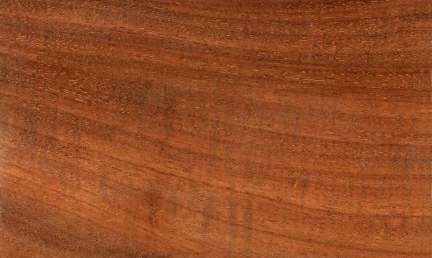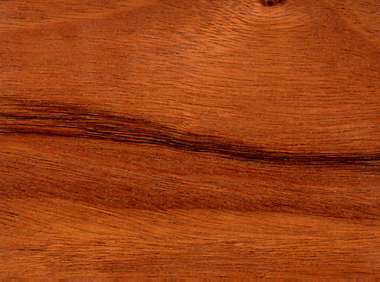 
Amendoim (Pterogyne nitens)
Family: Caesalpiniaceae
Common names: Ajunado, Amendoim, Amendoim bravo, Balsamo, Carne devaca, Cocal, Ebiraro, Guarucaia, Guiaro, Guiraro, Gui, Ibera-ro, Ibira-ro-mi, Ibiraro, Ibiraro-mi, Ibirarbiroro, Ibir, Ibyraro, Ivararo, Jacutinga, Jucutinga, Madeira nova, Oleo branco, Palo amargo, Palo coco, Palo mortero, Palo rosa, Pau amendoim, Pau Fava, Tapia colorado, Tipa, Tipa colorado, Tipilla, Viraro, Vivaruyraro
Distributed in: Argentina, Brazil, Paraguay (Latin America)
Distribution overview: Distributed in the north of Argentina, Paraguay, south of Brazil and Bolivia. It also occurs from the Parana River basin to the border with Bolivia. The tree grows typically at higher elevations and in sandy soils in the Paraguay River Basin. It is usually scarce at other sites, and it seldom grows in wet clayey soils.
Common uses: Agricultural implements, Bedroom suites, Bent Parts, Boat building: framing, Building materials, Cabinetmaking, Chairs, Chests, Concealed parts (Furniture), Cooperages, Desks, Dining-room furniture, Dowell pins, Dowells, Drawer sides, Fine furniture, Floor lamps, Flooring, Fuelwood, Furniture , Furniture components, Furniture squares or stock, Furniture, Hatracks, Interior construction, Interior trim, Kitchen cabinets, Light construction, Living-room suites, Millwork, Moldings, Office furniture, Paneling, Radio - stereo - TV cabinets, Railroad ties, Rustic furniture, Stools, Structural work, Tables , Tool handles, Trimming, Turnery, Utility furniture, Vats, Vehicle parts, Veneer: decorative, Wainscotting, Wardrobes, Wheel spokes, Wheels
Product sources: Trees in large sizes are rather difficult to find because of over-exploitation.
Environment profile: Widespread, abundant, and globally secure
Tree size: Tree height is 30-40 m
Colors: the heart isPale red to pink, Reddish brownand the sapwoodYellow, Yellowish brown.The grain isStraight, the textureMediumand the lusterPronounced
Natural durability: Moderately durable, Resistant to termites
Odor: No specific smell or taste
Silica Content: Siliceous
LightInduced Color Change: Darker
Kiln Schedules: Dry at a slow speed
Drying Defects: No end splitting, No twisting or warping
Ease of Drying: Rapidly
Comments: General finishing qualities are rated as satisfactory
Blunting Effect: High to severe
Boring: Good results
Carving: Good results
Cutting Resistance: Fairly Difficult to Very Difficult to saw
Gluing: Fairly Easy to Very Easy
Mortising: Fairly Difficult to Very Difficult
Moulding: Good moulding properties
Movement in Service: Good moulding properties
Nailing: Easy to nail
Planing: good
Resistance to Impregnation: Resistant sapwood
Response to hand tools: Fairly Difficult to Difficult to Work
Routing recessing: Fairly good response to preservative treatment
Sanding: Fairly good sanding characteristics
Turning: Good results
Painting: Satisfactory; Varnishing: Satisfactory
;
- Numerical data Metric
- Numerical data English
- Strength properties
- References
 |
 |
 |
 |
| Item |
Green |
Dry |
Metric |
| Specific Gravity |
0,65 |
|
|
| Density |
|
801 |
kg/m3 |
| Bending Strength |
700 |
1038 |
kg/cm2 |
| Crushing Strength |
341 |
500 |
kg/cm2 |
| Hardness |
|
752 |
kg |
| Impact Strength |
|
|
cm |
| Shearing Strength |
|
155 |
kg/cm2 |
| Stiffness |
111 |
115 |
1000 kg/cm2 |
| Tangential Shrinkage |
5 |
|
% |
| Radial Shrinkage |
3 |
|
% |
| Weight |
785 |
624 |
kg/m3 |
| Maximum Load |
|
|
cm-kg/cm3 |
| Toughness |
|
399 |
cm-kg |
| Static Bending |
|
|
kg/cm2 |
|
 |  |  |  | | Item | Green | Dry | English | | Bending Strength | 9967 | 14769 | psi | | Density | | 50 | lbs/ft3 | | Hardness | | 1658 | lbs | | Maximum Crushing Strength | 4862 | 7122 | psi | | Shearing Strength | | 2205 | psi | | Stiffness | 1585 | 1639 | 1000 psi | | Toughness | | 347 | inch-lbs | | Specific Gravity | 0.65 | | | | Weight | 49 | 39 | lbs/ft3 | | Radial Shrinkage | 3 | | % | | Tangential Shrinkage | 5 | | % | | Volumetric Shrinkage | 10 | | % | |
Max. crushing strength = medium 0
Shrinkage, Tangential = small
Shrinkage, Radial = small
Bending strength (MOR) = medium
Modulus of Elasticity (stiffness) = low
Hardness (side grain) = medium
Density (dry weight) = 46-52 lbs/cu. ft.
Bending strength (MOR) = low
Shearing strength (parallel to grain) = medium
Density (dry weight) = 53-60 lbs/cu. ft.
Modulus of Elasticity (stiffness) = medium
Max. crushing strength = high
Density = high
Compression strength (parallel to grain) = high
Bending strength (MOR) = very high
Bending strength (MOR) = high
Andy Poynter. 1993. Personal CommunicationCelulosa Argentina,1973,Libro del Arbol,Celulosa Argentina Buenos Aires 3 VolsChudnoff, M.,1984,Tropical Timbers of the World,U.S.A. Department of Agriculture, Forest Service, Forest Products,Laboratory, Madison.Mainieri, C., Pereira, J.A.,1965,Madeiras do Brasil,Anuario Brasileiro de Economia Florestal,17(17,PP135-416Mainieri, C.,1978,Fichas de Caracteristicas das Madeiras Brasileiras,Inst. Pesquisas TechnologicasRecord, S.J., Hess, R.W.,1943,Timbers of the New World,Yale University PressRizzini, C.T.,1978,Arvores e Madeiras Uteis do Brasil: Manual de Dendrologia Brasileira,Editora Edgard Blucher LTDA BrazilSao Paulo - Instituto de Pesquisas Tecnologicas,1956,Tabelas de Resultados obtidos para Madeiras Nacionais,Inst. Pesq. Tec. Sao Paulo, Brazil Bol., No.31(2nd Ed.)Takahashi, A.,1975,Compilation of data on the Mechanical Properties of Foreign Woods (Part 2,Central and South America,Shimane University, Japan, Research Report on Foreign Wood No.4Tortorelli, L.,1956,Maderas y Bosques Argentinos,Editorial Acme S.A.C.I. Buenos Aires
|









